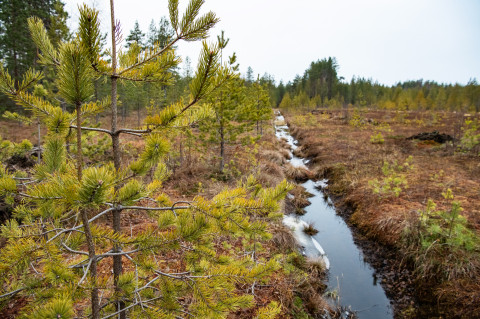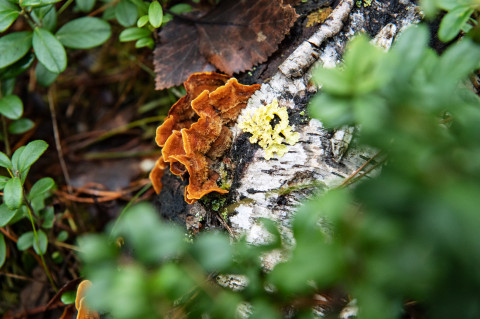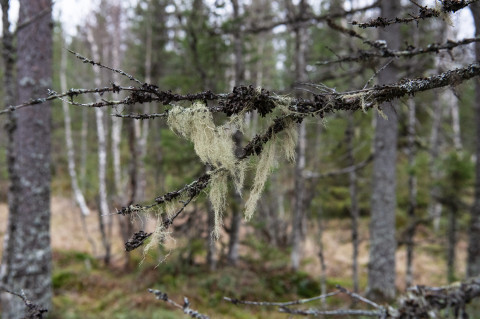In 2020, the University of Eastern Finland celebrated its 10th anniversary and marked the occasion by setting up a private conservation area in the Ylpässuo mire in Kiuruvesi, eastern Finland. Today, this conservation area is one of the seven Open Labs included in the European REWET project.
- Text Marianne Mustonen
- Photos Raija Törrönen and Jaakko Pohjoismäki
“To me, research conducted on this mire has been quite an adventure in the wild,” says Professor and Ylpässuo Open Lab leader Elina Oksanen of the Department of Environmental and Biological Sciences.
“My own background is in forest and plant research. However, our university is home to researchers with a long track record in research on peatlands and mires, and our department has conducted plenty of research into their ecology and Sphagnum moss species.”
Funded by the Horizon Programme of the European Union, the REWET project explores the state of wetlands across Europe, including Finland. The goal is to minimise harmful greenhouse gas emissions from wetlands and, using various conservation and restoration methods, maximise their carbon uptake.
REWET’s seven Open Labs explore wetland restoration and monitor greenhouse gas fluxes with the Eddy Covariance (EC) method. They also measure biodiversity, analyse ecosystem services, develop innovation activities, and model and produce scalable data.
“The Ylpässuo mire in Kiuruvesi is a scenic, minerotrophic open mire with several endangered plant and bird species. Seemingly untouched, the mire nevertheless is affected by earlier human activity. Drainage ditches in the nearby forest areas have deteriorated the mire’s water economy for decades,” Oksanen says.

And that’s precisely what makes Ylpässuo a perfect site for wetland research.
“Ylpässuo is completely different from the other six wetlands selected for the study. Each region has its unique climatic and geographical conditions, wetland types, social and cultural structures, pressures for change, vulnerabilities such as natural disasters, and governance structures,” Oksanen explains.
The mosaic-like mire is typical of Finland with its grassy and shrubby hummocks, metres-thick layer of Sphagnum moss, and also hard forest floor.
“This summer, Ylpässuo has been thriving due to abundant rainfall. The water balance of a mire ecosystem is known to affect carbon fluxes. Our preliminary results indicate that at times, the mire acts as a source of methane.”

New DNA methods for species identification
Starting research on the mire last spring required a lot of effort from the researchers and the research technician. No traces can be left on the conserved mire, nor can any kind of planks be built. All research equipment had to be carried to the site by hand or be pulled there on a sled. Electricity for the research equipment is produced by solar panels.
Oksanen has started plant research at the site. Working together with students of biology, she has identified different plant species and collected samples, and students have recorded their observations in the open Laji.fi database.
“Certain indicator species can be used to make interpretations of the humidity of, and the nutrients in, the peatland soil. Some more exotic plants, such as great sundews and lots of early-marsh orchids, have also been found on the mire. Sphagnum mosses that could be suitable for laboratory cultivation, are of specific interest,” she says.
“Thankfully, no cloudberries grow on this mire, so not too many people come wandering in.”
Ylpässuo is home to various animals, large carnivores and protected birds. One can also see lizards and spiders running on the Sphagnum moss.
“This is a complex mire with many different microhabitats and plenty of biodiversity,” Doctoral Researcher Jiri Vihavainen says.
Last summer, Vihavainen and other researchers visited several mires across Finland to collect material for DNA metabarcoding. Using DNA metabarcoding, the goal is to create a species inventory framework for these mires, allowing future monitoring and comparison to see how the insect fauna changes over the years. At the same time, DNA methods are being developed for species identification.
“My doctoral dissertation explores ‘dark diversity’ with the help of DNA methods. This mire was chosen for my study because of the REWET project – it’s nice to increase the geographical coverage by including some material from North Savo. The other mires are located in Lieksa, Lapland and Pyhtää,” Vihavainen says.

“Of the vertebrates, we observed 20 different bird species as well as common frogs, lizards, a viper, a bear and a beaver. We also conducted a butterfly and pollinator line transect count on the mire for the REWET project. We counted a total of 31 butterfly species and eight bumblebee species – mostly species that are commonly found on mires. For example, there were no endangered species among them. However, a noteworthy butterfly species found on the mire is the rather rare and local small eggar,” Vihavainen says.
Of the orthoptera, at least the large marsh grasshopper, the common green grasshopper and the Roesel’s bush cricket were found on the mire. Of the spiders, mainly the raft spider and the green crab spider, or crab spiders in general, come to mind. Of the heteroptera, the assassin bug (Coranus aethiops) was found on the mire, but it is a very local and rare species. The deer ked population, too, was found to be very viable. All species observations have been recorded in the Laji.fi database.
“We are yet to analyse material from two Malaise traps, but this material, consisting mainly of the diptera and the hymenoptera, has more than 50,000 individuals. This material will be DNA metabarcoded this autumn, providing us with a more comprehensive list of species,” Vihavainen says.
Measurement data is used for climate modelling
Besides the visible parts of the mire, the conditions in the atmosphere and ground water are also being studied.
Fluxes of greenhouse gases, carbon dioxide and methane are measured using the Eddy Covariance (EC) method which measures the carbon flux and water molecules in the atmospheric boundary layer.
“Eddy Covariance is the most reliable and accurate method for studying the carbon cycle of large areas, i.e., those over one hectare in size. The EC station operates automatically and requires little maintenance. The amount of data obtained is vast, and their storage, processing, analysis and visualisation takes time,” Oksanen says.
The measuring devices are placed in a specific location on the mire according to wind direction, and so far, they have worked well without any remarkable interruptions.
“Liang Chen, a doctoral researcher at our department, has obtained very good data from the measuring devices. Once the data have been analysed, we’ll see whether the mire acts as a sink or as a source of carbon, and how the situation changes over the course of the summer,” Oksanen says.
The data obtained from the measuring devices are stored in a common EU database and used for modelling.
Ylpässuo’s water quality, on the other hand, is studied by researchers from the University of Oulu using pipes installed on the mire. Led by Professor Tiina Leiviskä, the Chemical Process Engineering research group investigates water quality, nutrients, conductivity, pH, temperature, dissolved organic matter and dissolved gases.
Measurements at Ylpässuo have been completed for the year, and only maintenance is currently ongoing at the site. In March, the solar panels are expected to start producing electricity again, and another season of research can begin.

The University of Eastern Finland’s efforts to conserve the mire are a good example of environmental responsibility.
Elina Oksanen
Professor
“Hopefully, more area of Ylpässuo will be conserved and its restoration could continue. It is also important to give nature a chance to restore itself, because that’s what nature does best.”
Wetland ecosystems have been deteriorating across Europe for centuries. The main reason for ecosystem deterioration is large-scale drainage for agriculture and forestry, and for peat production. Wetlands, especially mires, capture large amounts of carbon, and disturbances may lead to high greenhouse gas emissions.Global warming and changes in rainfall also lead to drying of wetlands, which increases greenhouse gas emissions and natural disasters. The conservation and restoration of wetlands is becoming increasingly urgent.
The conservation and restoration of wetlands is essential for achieving the climate and environmental objectives set by the EU, and globally. These include, among others, the EU’s Nature Restoration Law, or the Kunming-Montreal Biodiversity Agreement, which sets the target for increasing the number of conserved areas globally to 30 percent of land, inland water and marine areas, as well as increasing the restoration of 30 percent of degraded habitats (CBD 2022).
A better understanding of wetland carbon dynamics is essential for effective mitigation of climate change, as is the development of measures that support conservation and restoration in different environments.

REWET
REWET (REstoration of WETlands to minimise emissions and maximise carbon uptake – a strategy for long term climate mitigation) is a research project funded by the EU’s Horizon Programme in 2022–2026. The project is coordinated by Idener, a Spain-based private research company. The University of Eastern Finland coordinates the Ylpässuo Open Lab.
In line with the European Green Deal objectives, the project’s research and innovation activities provide new insight into the complexity of maintaining, conserving and restoring wetland ecosystems. REWET analyses and identifies the best restoration strategies to maximise the carbon uptake and to minimise the greenhouse gas emissions of wetlands.
Learn more: https://www.rewet-he.eu/




